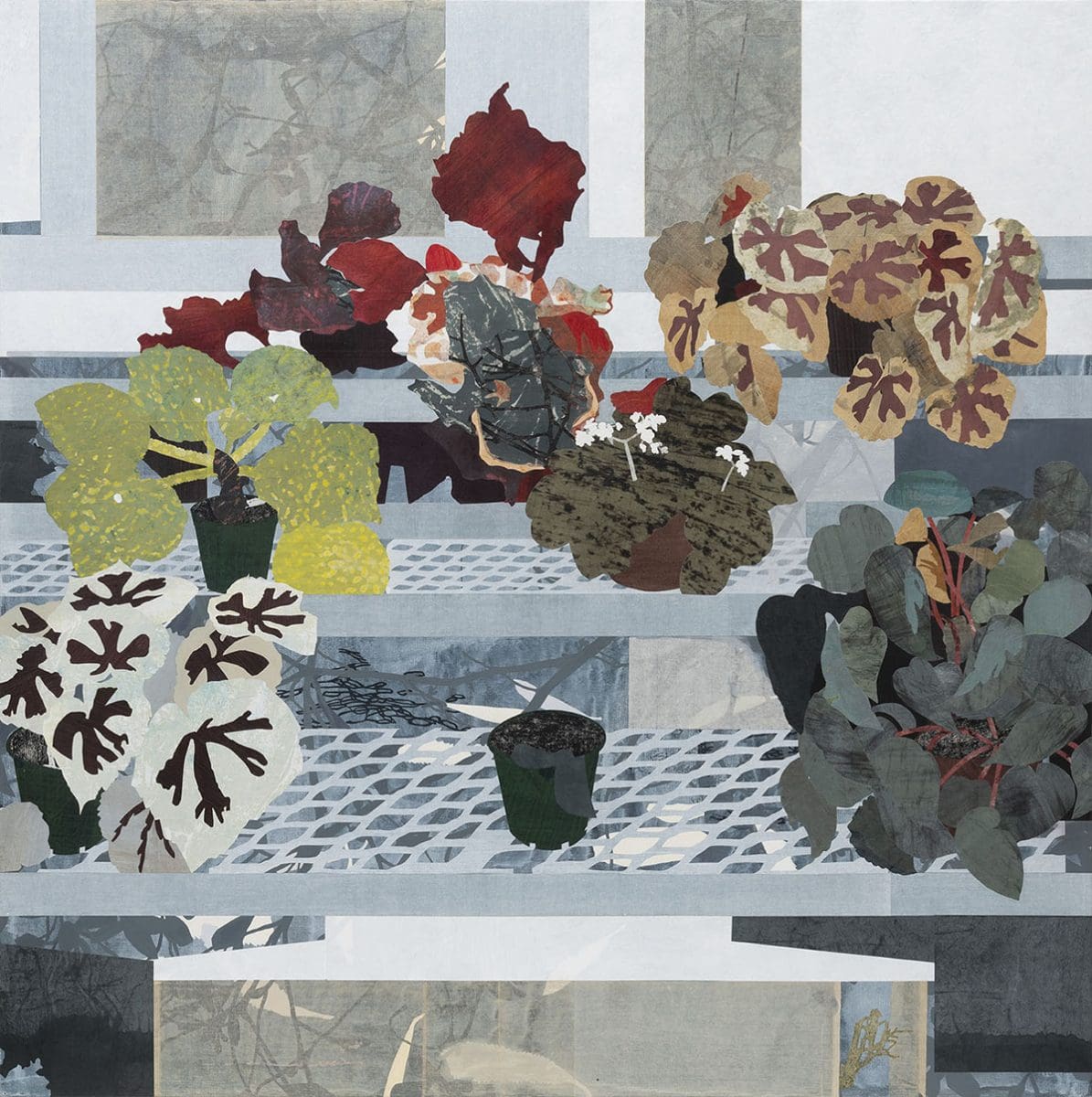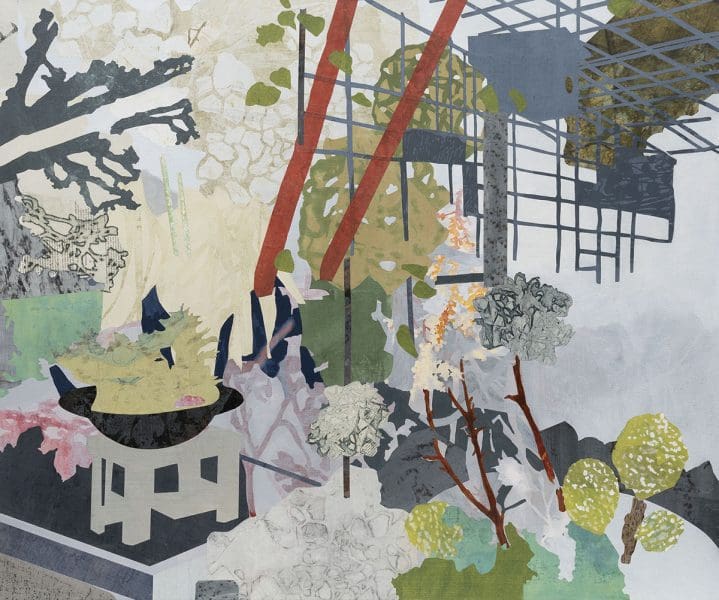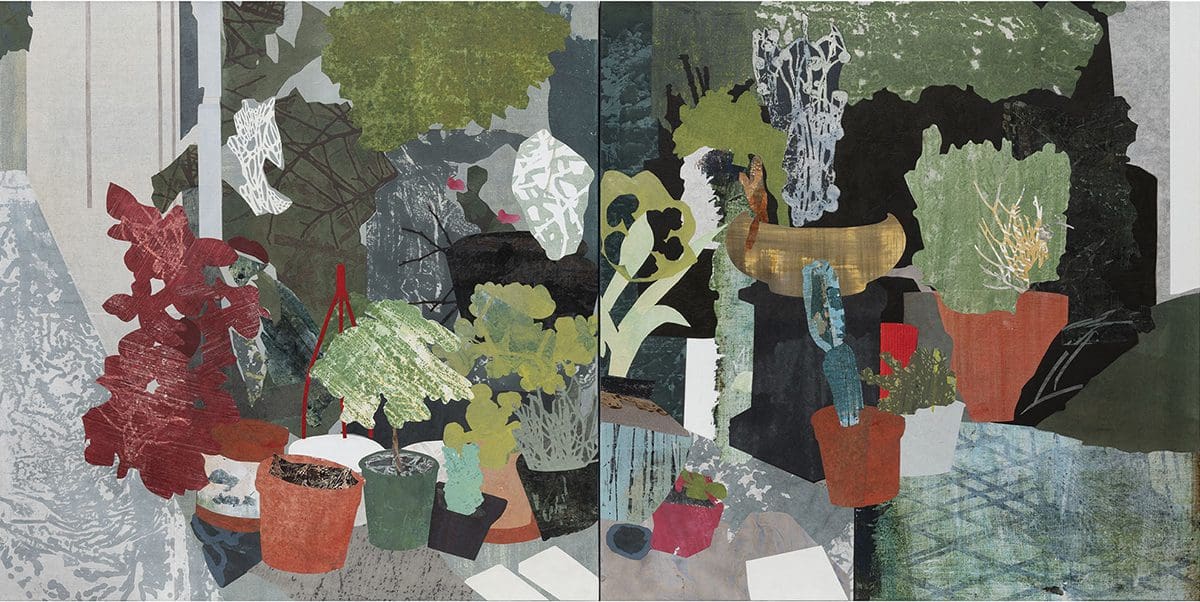
Piercing the veil
A new exhibition at Buxton Contemporary finds a rich complexity in the shadowy terrain between life and death.

Nicola Moss, West Green, 2018, synthetic polymer paint, painted papers, relief and collagraph prints, oil pastel, frottage, gesso, matte varnish on stretched canvas, 90 x 90 cm. Photograph by Carl Warner. Courtesy of the artist and Onespace Gallery.

Nicola Moss, Shelf life, 2018, synthetic polymer paint, painted papers, relief prints, oil pastel, frottage, gesso, matte varnish on stretched canvas, 120 x 120 cm. Photograph by Carl Warner. Courtesy of the artist and Onespace Gallery.

Nicola Moss, Eat your greens I, 2018, synthetic polymer paint, painted papers, relief and collagraph prints, oil pastel, charcoal and graphite frottage, gesso, matte varnish on stretched linen,100 x 120cm. Photograph by Carl Warner. Courtesy of the artist and Onespace Gallery.

Nicola Moss, Westbourne, 2019, synthetic polymer paint, painted papers, relief and collagraph prints, oil pastel, gesso, matte varnish on stretched canvas, 90 x 90 cm. Photograph by Carl Warner. Courtesy of the artist and Onespace Gallery.
Nicola Moss’s collaged works represent a soulful and civic-minded inquiry into the importance of green spaces amid the congested urban environments that increasingly define 21st century existence. And by extension, they explore the often uneasy intersection between politics, economics and ecology.
The Gold Coast-based artist’s exhibition Greenspace, at Brisbane’s Onespace gallery, is the latest instalment of her aesthetic interpretation of this distinctly societal theme. These works on paper – colourful, moving and experimental – pose important questions regarding sustainability and how wilderness and open space might be incorporated into city life for the sake of our well-being.
Greenspace is part of Moss’s wider City and Nature project, a longstanding labour of love that has also been seen in shows elsewhere in Australia and overseas.
“City and Nature as a project recognises that there are many influences and complexities shaping green spaces in cities,” says Moss, “including town planning, aesthetics, maintenance regimes, liveability, biodiversity and heritage. For me, the sustainability of green space in our everyday lives is intrinsic to our well-being – physically and mentally.”
Moss’s preoccupation with the collision of civilisation and the natural world goes back to the very early days of her artistic practice in the late 1980s. Living on the Gold Coast, she has witnessed first hand the march of suburban development across the landscape.
“Living here and witnessing growth and change in this region over the past 15 years has been a huge influence on my practice. Watching nearby bush and farmland being cleared to bare ground in 2005, to make way for medium and high density housing, was a catalyst for my questions, beginning with: How do we find balance between conservation and development? What is sustainability?
The method by which Moss creates these works is another intriguing dimension to Greenspace. She relies on an archive of papers that begin as white or cream, which are then coloured using acrylic paint, graphite and charcoal frottage, printmaking, rust stain and more as she goes about her city explorations.
“This initial process with the papers enables me to capture nuances of experience and place in the material itself,” says Moss. “They travel with me on walks, so an impression from tree bark frottage rubbing, for example, can be incorporated into the final work using a collage process.”

Despite this practice being informed by en plein air painting, Moss insists that life experience has had more bearing on the evolution of her work than other artists. Although she does acknowledge the influence of the similarly eco-minded Australian artist John Wolseley.
While Moss’s art is a compelling visual proposition on its own, free from the context of green space, she is perhaps less preoccupied with the innovations of technique and form, or impressing the art community, than she is with initiating a public dialogue about green space: a discussion she has undoubtedly started.
“I’ve had insightful conversations with residents of several communities. Their broad range of thoughts on the value of plants in everyday life is a growing and valued archive for me,” she explains. “I can reference and reflect on these when physically exploring environments on foot and when working in the studio. On many occasions I’ve been surprised and delighted by the intimate sharing of personal stories that have come from asking fairly simple questions.”
“I asked my seven-year-old niece how she would feel if there were no plants, trees and flowers in the world,” Moss adds, “and she drew me a picture with one word beside: ‘lonely’.”
Greenspace
Nicola Moss
Onespace
2 February–2 March